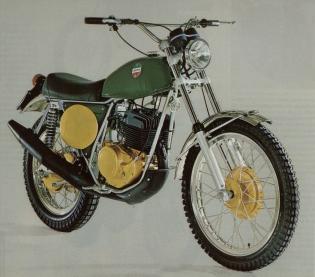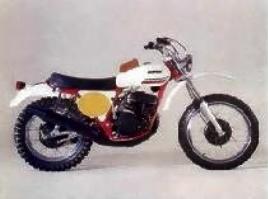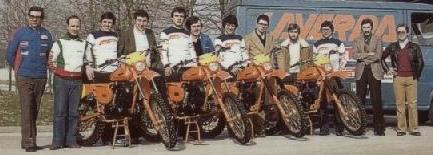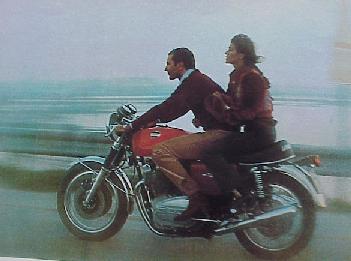 |
Offroad |
 |
One had already seen some Laverda offroad motorbikes in the fifties (they were often modified 75cc road bikes then pure offroad racers), then in the sixties, thanks to the 125cc "Regolarita".
But it was really in 1970 that the factory decided to produce a specific offroad motorbike.
The project had to wait sometimes because of the new 1000cc triple production and the building of the new factory near Breganze.
So, the first offroad bike came to the 1973 Milan Motor show and has been produced since 1974.
It was the Laverda 250 Chott, a two-stroke of 246,9cc and 26 hp, equipped with a double electronic ignition and double spark plugs (twin spark), 32mm Dell'Orto carburettor, 5 speed gearbox.
One of the characteristics of this motorbike was that the angle of the fork could be adjusted in 3 positions: 25°, 27,5° and 30°. Another was the magnesium cranckcases and wheel hubs. |
| |
|
 |
After some times, it appeared that the public was waiting for a less-sophisticated bike, more for leasure and probably less for competition, and too at a lower price.
So, Laverda produced in 1976 a different machine (even if it remained on the Chott basement), without speedo and rev counter, without magnesium parts, which was the 250 TR2.
Compared to the Chott, the bodywork was in plastic instead of metal and the bike was lighter.
On a technical point of view, the 250 TR2 was far less sophisticated than the Chott but it was finally more able to answer to the public expectations of that time. |
|
 |
However, Laverda wished to conceive a bike really able to win the best offroad races of that time and searched for the best solutions.
An agreement came in 1976 with Husqvarna, who had a very good knowledge of the offroad races: Husqvarna furnished the engines and a constant technical help, and Laverda was charged to build the motorbikes around the Husqvarna engine.
Progressively, Laverda stopped the production of the TR2 and two new Laverda bikes came on the market, the HW 125 and the HW 250.
To improve the bikes, Laverda engaged Italo Forni, winner of the Italian motocross championship, and other pilots like Gianni Basso.
Forni made the tests and the bike development, he also raced the bikes (especially the 125 HW) during national and international events with good results.
Giulio Franzan, famous collaborator of the factory, managed the special Laverda offroad team. |
| |
|
| |
 |
But it has been necessary to wait until 1985 to see a new Laverda offroad motorbike.
The factory had already important financial problems and the staff looked for a way to enlarge the production without spending excessive budgets.
So, the idea was to produce a big offroad bike, using an existing engine.
Then, it became clear that the best engine for that purpose was the twin of the 500 road bike, sophisticated and rather light, powerful.
It had just to be modernized and adapted to the offroad specific use.
The staff decided to re-bore it at 600cc (exactly 571,6) and to fit new camshafts able to allow more power at low range. A twin carburettor (automotive origin) improved the torque at low and mid-range.
For the rest, the engine kept the 4 valves per cylinder and the balancer shaft (though sligtly different of the road bike).
The power was of 50 hp at 7500 rpm and the torque was important, reaching near 4500 rpm.
As for the frame and suspension, the factory used very good products, like a 42mm fork and a rear Soft Ramble monoshock. The bodywork was in ABS plastic.
Everything on this bike was to the best level to compete with the best foreign productions, even if the weight was a bit high (157 to 180 kg depending of the versions).
However, in spite of a slightly different last version in 1989, the rather high price and the financial problems of the factory have restricted the success of the 600 Atlas.
It seems that only around 500 bikes have been sold from 1986 to 1989. |
| |
Finding parts...
The situation is desperate for the 250 Chott and the TR2. It seems that there are no parts source in the world. Then, it is necessary to try to adapt some parts coming from
other bikes, and even to manufacture the rarest parts to keep these motorbikes running. Fortunately, the engines are rather simple (2 strokes).
As for the Laverda-Husqvarna, things are a lot easier because the Husqvarna shops or the offroad specialists have yet a lot of parts.
Concerning the Atlas, the engine being directly derivated from the 500 road bike and the basement for the 650/668 Zané bikes, parts are available from the best 500 Laverda
specialists:
- Wolfgang Haerter (Canada): laverda@lightspeed.ca, large stock of parts, excellent service.
- Orange cycle Team (Germany): Tel: 02251-970752, Fax: 02251-970753, octeam@gmx.de, workshop and parts, ask for Roger.
|
| |
|
| <<< Back to Menu |






